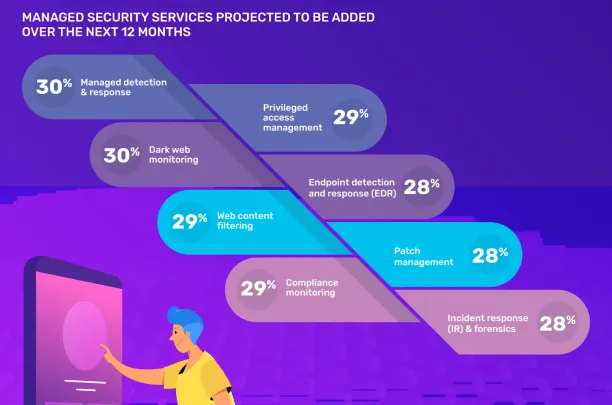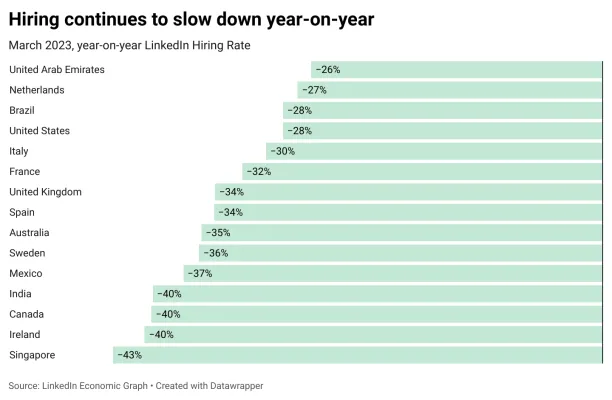Top 3 MSP Scalability Challenges in 2024 & How to Solve Them
Since the pandemic, managed service providers (MSPs) have seen increased interest (Figure 1).

That growth is partly fueled by companies going remote and requiring expert IT assistance to support and maintain operations. And the dependency on managed services seems to be growing: By 2025, at least 60%1 of organizations will be dependent on MSPs.
However, an expanding client base2 and scale, the costs and an evolving technology landscape, is creating the following major scalability challenges for MSPs:
- Talent and skills shortages: 66%
In this article, we will explain in more detail how cloud managed service providers can offer their customers a more attractive value proposition by dealing with their top 3 scalability challenges.
Disclaimer
A MSP business could face the same business challenges any other company faces. Writing a generic best practices article would not have been value-adding. So, we limited this list to solely focus on documented, data-backed, and publicly-verifiable MSP business challenges specifically.
1. Improving client satisfaction
1.1. Listening to what customers want
MSPs are struggling3 with signing new clients and retaining the existing ones. This lowers profitability, reduces operational efficiency, costs more and hurts scaling initiatives.
To mitigate these challenges, MSPs can do the following:
Managed services should follow industry growth trends to see what their clients need. For example, in 2023, the following security services are expected to be offered more4(Figure 5).

Or because5 the security concerns of clients about:
- Viruses/malware
- COVID-19 related scams or threats
- Phishing attempts
- Endpoint threats
Are increasing, more MSP businesses are offering:
- Antivirus
- Endpoint threats detection
- Anti-phishing solution
- Password protection, etc.
MSPs should follow market demands and other MSPs to offer solutions around the common roadblocks to make their clients happier. Should MSP owners need to offer a customized service according to their customers’ needs, they can establish strategic partnership with technology providers.
Learn more about choosing an RPA technology partner by reading our whitepaper on the topic:
1.2. Minimizing disjointed integrations
61%6 of MSPs’ clients see having remote workers as their top challenge (Figure 3). An extension of having remote workers is dealing with disjointed applications and having too many different tools and resources to work with.

MSPs can focus on consolidating tools, processes and platforms they offer their old and new customers. For instance, opt for comprehensive solutions that offer multiple functionalities, like RMM, PSA, and IT documentation within a single platform. This helps them handle more inquiries without needing to invest in more infrastructure.
Consolidation of disjointed application is also particularly important to most MSPs (Figure 4)7:

2. Solving the talent shortage
Talent shortage is a macro challenge and not limited to one company or industry, with global hiring having a YoY decline8(Figure 2).

But the IT sector is seemingly hit harder than some. Since 20169, there’s a 145% increase in the number of IT decision-makers who say there’s a critical workforce skill gap, with 76% actively suffering from it.
With growing market demands, a scalable business should be equipped to handle their growing client base. MSPs can address their staff shortage challenges in the following ways:
2.1. Investing in training & development
Courses and certifications can help MSP’s employees develop expertise in various IT areas, like networking, cloud computing infrastructure, virtualization, cybersecurity, IT service management, and project management processes.
Popular courses include:
I) Amazon Web Services (AWS) Certifications
- AWS Certified Solutions Architect – Associate: Designing and deploying AWS-based solutions
- AWS Certified SysOps Administrator – Associate: Skills required for deploying, managing, and operating AWS-based systems
II) Cisco Certifications
- Cisco Certified Network Associate (CCNA): Networking fundamentals– routing, switching, and basic network troubleshooting
- Cisco Certified Network Professional (CCNP): Advanced networking skills– network design, implementation, and troubleshooting
III) CompTIA Certifications
- CompTIA A+: Fundamental IT skills– hardware, software, and networking
- CompTIA Network+: Networking concepts, tools, and best practices
- CompTIA Security+: Foundational knowledge in IT security concepts, tools, and best practices
IV) Microsoft Certifications
- Azure Administrator Associate: Skills and knowledge related to Azure administration, including managing cloud services and resources.
- Azure Solutions Architect Expert: Designing and implementing Azure-based solutions
- Modern Desktop Administrator Associate: Skills required to manage and maintain Windows 10 and Microsoft 365 environments
V) TIL® Certifications
- ITIL® 4 Foundation: Foundational knowledge of IT service management best practices based on the ITIL® framework
- ITIL® 4 Managing Professional: Advanced IT service management concepts and practices
VI) VMware Certifications
- Data Center Virtualization (VCP-DCV): Skills related to designing, installing, and managing VMware vSphere environments
- Network Virtualization (VCP-NV): VMware NSX networking and security solutions
VII) Project Management Certifications
- Project Management Professional (PMP): Project management best practices and methodologies
- Certified ScrumMaster (CSM): Agile project management and the Scrum framework
2.2. Participating in industry events and networking
Participating in industry events and networking can help MSPs address their skill gaps through:
I) Connecting with potential talent
Interacting with skilled professionals, identifying potential talent, and building a pipeline of candidates for current and future hiring needs.
II) Learning about the latest trends and technologies
Attending presentations, panel discussions, and workshops that cover the latest trends and technologies in the IT industry. This helps MSPs stay informed and adapt their services accordingly.
III) Engaging with thought leaders and experts
Networking at industry events allows MSPs to connect with thought leaders, experts, and peers, facilitating the exchange of ideas, best practices, and insights that can help MSPs address skill gaps and improve their service offerings.
IV) Building brand awareness and credibility
By participating in industry events, MSPs can showcase their expertise, share success stories, and demonstrate thought leadership, which can help attract skilled professionals to their organization.
Some specific software industry events and conferences relevant to MSPs include:
- MSPWorld: Offers networking opportunities, presentations, and panel discussions on various topics related to the MSP industry.
- Channel Partners Conference & Expo: A major event for channel partners, including MSPs, VARs, and agents, this conference features industry speakers, workshops, and networking opportunities.
- IT Nation Connect: A premier event for MSPs and IT service providers, offering educational sessions, keynote presentations, and networking opportunities.
- ASCII IT Success Summits: They provide MSPs with opportunities to network, learn from industry experts, and participate in roundtable discussions.
- DattoCon: Annual conference for MSPs that focuses on business growth, technology trends, and networking opportunities.
3. Solving compliance and cybersecurity concerns
Before the 4th of July weekend of 2021, a ransomware attack10 on Kaseya software, used by many MSPs, shed light on the vulnerability of the outsourced managed services sector. 1,500 businesses were disrupted by the attack. Unsurprisingly, MSP’s clients have a security posture problem and are turning to MSPs for help:
- 77% of MSPs’ clients were hit by a cyberattack
- 65% of MSPs increased their revenue from selling cybersecurity-related services
But it’s not only the clients who should be prepared. As MSPs themselves grow, so does their surface attack area. Like putting on the oxygen mask in the airplane, MSPs should first help themselves before others.
The following steps can help MSPs in improving their security posture:
1. Implementing more robust security policies
Develop and enforce comprehensive security policies that cover aspects such as access control, data protection, incident response, and employee training. Regularly review and update these policies to ensure their effectiveness.
2. Regularly patching and updating systems
Ensure that all software, applications, and operating systems are regularly updated and patched to address security vulnerabilities. This includes your MSP’s own systems, as well as those of your clients.
3. Conducting regular security assessments
Regularly assess your MSP’s security posture and identify vulnerabilities through penetration testing, vulnerability assessments, and security audits. Address any identified weaknesses and continuously work to improve your security measures.
4. Leveraging threat intelligence
Stay informed about the latest cybersecurity threats, vulnerabilities, and trends by leveraging threat intelligence feeds and resources. Use this information to adapt and enhance your MSP’s security measures as needed.
5. Deploying intrusion detection and prevention systems (IDPS)
Implement IDPS solutions to monitor network traffic, detect potential threats, and prevent unauthorized access or data breaches.
For more on MSPs
To learn more about Managed Service Providers (MSPs), read:
- MSP ChatGPT: Leveraging Conversational AI to Drive Success
- 15 Best Practices for Sustainable MSP Growth
If you have any other questions on the topic, please reach out to us:
External Links
- 1. “Managed Services Market to Reach $393.72 Billion by 2028.” GlobeNewswire. July 7, 2022. Retrieved on May 5, 2023.
- 2. “2022 Global MSP Benchmark Survey Report.” Kaseya. Retrieved on May 5, 2023.
- 3. “Managed service providers business challenges worldwide in 2022, by region.” Statista. Retrieved on May 5, 2023.
- 4. “Datto’s Global State of the MSP Report: Looking Ahead to 2023.” Datto. Retrieved on May 5, 2023.
- 5. “Datto’s Global State of the MSP Report: Looking Ahead to 2023.” Datto. Retrieved on May 5, 2023.
- 6. “2021 Global MSP Benchmark Survey Report.” Kaseya. Retrieved on May 5, 2023.
- 7. “2021 Global MSP Benchmark Survey Report.” Kaseya. Retrieved on May 5, 2023.
- 8. “Some slack has returned to labor markets, but workers continue to hold power.” LinkedIn Economic Graph. April 6, 2023. Retrieved on May 5, 2023.
- 9. “Global Knowledge 2021 IT Skills and Salary Report.” Skillsoft. Retrieved on May 5, 2023.
- 10. “The Kaseya Ransomware Attack Is a Wakeup Call for MSP-Reliant IT Shops.” DataCenterKnowledge. July 13, 2021. Retrieved on 5 May, 2023.

Cem is the principal analyst at AIMultiple since 2017. AIMultiple informs hundreds of thousands of businesses (as per Similarweb) including 60% of Fortune 500 every month.
Cem's work has been cited by leading global publications including Business Insider, Forbes, Washington Post, global firms like Deloitte, HPE, NGOs like World Economic Forum and supranational organizations like European Commission. You can see more reputable companies and media that referenced AIMultiple.
Throughout his career, Cem served as a tech consultant, tech buyer and tech entrepreneur. He advised enterprises on their technology decisions at McKinsey & Company and Altman Solon for more than a decade. He also published a McKinsey report on digitalization.
He led technology strategy and procurement of a telco while reporting to the CEO. He has also led commercial growth of deep tech company Hypatos that reached a 7 digit annual recurring revenue and a 9 digit valuation from 0 within 2 years. Cem's work in Hypatos was covered by leading technology publications like TechCrunch and Business Insider.
Cem regularly speaks at international technology conferences. He graduated from Bogazici University as a computer engineer and holds an MBA from Columbia Business School.
Sources:
AIMultiple.com Traffic Analytics, Ranking & Audience, Similarweb.
Why Microsoft, IBM, and Google Are Ramping up Efforts on AI Ethics, Business Insider.
Microsoft invests $1 billion in OpenAI to pursue artificial intelligence that’s smarter than we are, Washington Post.
Data management barriers to AI success, Deloitte.
Empowering AI Leadership: AI C-Suite Toolkit, World Economic Forum.
Science, Research and Innovation Performance of the EU, European Commission.
Public-sector digitization: The trillion-dollar challenge, McKinsey & Company.
Hypatos gets $11.8M for a deep learning approach to document processing, TechCrunch.
We got an exclusive look at the pitch deck AI startup Hypatos used to raise $11 million, Business Insider.
To stay up-to-date on B2B tech & accelerate your enterprise:
Follow on
Comments
Your email address will not be published. All fields are required.